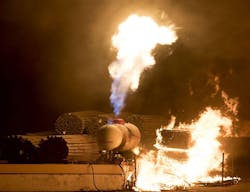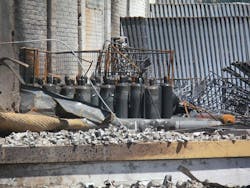Technical Rescue: Double Duty: Wildfire & Hazmat
Responses to normal wildland fires and hazmat incidents can be concerning on their own (who knows how “normal” is defined anymore), but try responding to a wildland fire that involves a hazmat incident or vice versa.
Sleepy Hollow Fire
With temperatures at more than 100 degrees F, humidity at 9 percent and winds out of the west at 35 mph, the Sleepy Hollow Fire blew up on June 28, 2015. The fire started in the hills west of downtown Wenatchee, WA, which is approximately 150 miles east of Seattle. Evacuation levels were established for immediate evacuations.
Embers from the fire that carried on the breeze floated into the downtown section of the city. At 9:14 p.m., several reports came in to dispatch concerning a major fire downtown.
Falling embers ignited recycled cardboard at Michelsen Packaging Company, which was in the center of downtown. That caused extension to nearby buildings. Four businesses were in danger of destruction: Michelsen Packaging, Blue Bird Processing, Stemilt Growers and Northwest Wholesale.
Because of the operations of the businesses, several hazardous materials were stored inside of the buildings. Some of the hazardous materials that were in buildings, according to the Washington State Department of Ecology’s product inventory before the incident, were:
- Ammonia (liquid), 12,200 lbs. (vapors are extremely irritating and corrosive, burns, frostbite)
- Chlorine (liquid), 28,670 lbs. (inhalation hazard, burns, corrosive, toxic)
- Chlorophacinone (solid), 25,050 lbs.
- GlyStar (glyphosate) (liquid), 66,925 lbs. (herbicide)
- Methyl bromide (liquid), 16,625 lbs. (poisonous, irritating, corrosive, toxic)
- Paraquat (liquid), 29,797 lbs. (toxic)
- Propane (liquid), 13,970 lbs. (extremely flammable, vapors are heavier than air, spreads along the ground)
Resources were limited because of the responders and equipment that were in use at the wildland fire. Command and control and firefighting elements were limited, too. All of a sudden, company-level officers were forced to assume the role of divisional incident commanders, working to assess the situation.
Risk assessment and prioritization focused on how resources should be dedicated and on what wasn’t savable because of the fire spread. Public safety and how to minimize the dangers of the hazardous materials were huge concerns. A complete hazmat response was approximately two hours away, so decisions were critical to hopefully limit the dangers to the general public.
Incident command
The department chain of command was overwhelmed and limited for a lengthy period of time. As noted above, company officers were pressed into divisional supervisor roles at both strategic and tactical levels to form an operational plan. Some of these individuals were seasoned company officers, but some were less experienced, particularly when it came to what was needed to act in a divisional supervisor role.
The decision was made, based on the risk assessment, to go defensive and to protect exposures and limit the spread of the fire. Also a factor: Given the hot weather, several members were treated for heat exhaustion, even during the evening hours.
The partnership between public agencies (local and state), private industries and others contributed to limiting the further spread of the downtown fire.
Communications was a challenge. Many resources were on scene, and many people talked on the same frequencies. Cellphones for one-to-one communications worked well until the cell tower burned.
The effect of the fires on several large buildings along with the threat of exposures from the chemicals that were stored within the buildings also led command to concentrate on downrange effects from the smoke.
Hazmat
Chemical inventories weren’t available at the time of the fire. Even if they were, the limited personnel who were on scene didn’t understand chemicals and their reactions.
No chemical protective equipment was available. Fire responders were instructed to wear their full PPE ensemble, including SCBA where needed. Responders were instructed to stay upwind from the incident and to don their SCBA should the wind direction change during operations.
Personnel maintained a perimeter upwind and 150 yards from the hazardous material leaks and vapors.
Incident command system training (i.e., preplanning, practicing defensive hose lays) and adaptability assisted greatly in the process of fighting the fire. Using worst-case scenarios and predictions—understanding where this event was going and what was projected to happen based on the recon fire conditions—also was a big help when the incident developed into a conflagration.The aftermath
By late in the morning of June 29, the winds in the area subsided, and a brief, heavy rainstorm fell on the affected fire area in downtown. Nevertheless, shelter-in-place warnings were left in place downtown, given the existence of dangerous smoke that was emanating from the downtown buildings. Furthermore, an ammonia cloud that was visible from the location of the remnants of the Blue Bird Processing facilities extended to the area that was covered by the shelter-in-place order.
Several more days were required to recover from the disaster in downtown Wenatchee.
A Type 2 incident management team (IMT) was ordered for the overall management of the incident. The Southwest Washington Type 2 IMT was assigned. Specialized teams were requested to assist in the mitigation of the downtown hazmat incident. Chemicals were inventoried to ensure that what currently existed in the area of the fire was accounted for and made safe or removed.
The Washington State Department of Ecology and cleanup companies were called in, too, including in regard to mitigation of the materials to a safe disposal site.
Lessons learned
- Anything can happen at any time. Responding to multiple high-hazard incidents can deplete an already exhausted resource network. Have a plan prior to the incident.
- Training for some of the officers who responded to the incident paid off in regard to risk assessments and evaluation of hazards.
- Determination of what could be saved and what already was lost contributed to determining the operational plan during the incident.
- Based on fire growth and potential, decisions were required to ensure that the fire didn’t jump the Columbia River into East Wenatchee.
- Have a salvage/recovery/relief plan for existing resources.
Thank you to Deputy Chief of Operations Andrew Davidson of the Wenatchee Valley, WA, Fire Department for his contribution to this article.
Protecting a Rail Corridor
About the Author

Scott Lancaster
Scott Lancaster serves as a deputy state fire marshal at the Washington State Fire Marshal’s Office, specializing in hazmat/WMD. Previously, Lancaster was a member of the Churchville, NY, Volunteer Fire Department and the deputy fire coordinator and county fire instructor for the Monroe County, NY, Fire Bureau, among others. His training includes fire, hazmat, WMD and special operations provided by the National Fire Academy, the NFPA and FEMA. Lancaster is a member of the NFPA 1010: Standard for Firefighter, Fire Apparatus Driver/Operator, Airport Firefighter, and Marine Firefighting for Land-Based Firefighters Professional Qualifications committee and an alternative member of the NFPA 470: Hazardous Materials/Weapons of Mass Destruction (WMD) Standard for Responders committee.

